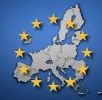The new Europe: Vision and hope
First of four parts looking at the future of Europe after the historic entry of 10 new countries to the European Union on May 1.
The European Union takes a visionary leap into the future on May 1, when 10 nations in Southern, Central and Eastern Europe will be admitted to its ranks. At a single bound, the “15” will become the “25.” A Union of 350 million people will add another 75 million or so.
The vast expansion will be the largest growth spurt in the highly successful history of European unification going back more than half a century. It fulfills the decision of the EU’s Copenhagen summit in December 2002.
The EU is already a complex and colossal structure, and the problems with regulating it and developing flexible and credible political accountability within it are legion. The European Union has also been plagued for decades with miserably low growth rates and steadily rising rates of unemployment. Its economic locomotive, Germany, is in the doldrums, and the economic policies of Chancellor Gerhard Schroeder look to make things for Germany – and the rest of the EU — far worse.
But the EU leaders meeting in Copenhagen agreed to allow no fewer than 10 more nations in Southern and Central Europe to join them. That means that in a few days, the EU will have to absorb 75 million more people speaking eight additional languages. The combined current gross national product of all the nations that will be involved is more than $9 trillion, close to that of the United States.
That will give the EU a larger population and more ethnic complexity than either the United States or the old Soviet Union ever had. Only China and India will have larger populations.
The Copenhagen decision combined amazing daring, vision and generosity with vast, even wild, uncertainty.
First, it was an attempt to close the chasm between Eastern and Western Europe that opened up after the Soviet-communist occupation of the eastern half of the continent at the end of World War II. Even since the collapse of communism in 1989-91, the newly independent nations of Central and Eastern Europe have felt like hungry orphans locked out of the EU’s “rich man’s club.” The Copenhagen decision is meant to redress that once and for all.
Danish Prime Minister Anders Fogh Rasmussen, who hosted the historic 2002 summit, made this point at the time. “Today we have closed one of the bloodiest and darkest chapters in European history,” he said. “We decided to heal our continent. We decided to create one Europe.”
If this “great leap forward” toward European unity works, it will accomplish much.
First, it may re-energize the nations of Western Europe with a more generous and optimistic vision of what the European family of democratic nations is going to be. And it may force them to finally deregulate their own comfortable internal markets and scrap or radically reform their old Common Agricultural Policy with its enormous financial subsidies for the farmers of the West.
Second, it may give an enormous boost to economic and ultimately social and creative development in the old EU nations, much as the great eras of unlimited immigration did to the United States.
For like America, the EU will add scores of millions of culturally compatible, ambitious, dynamic and hard-working people that the old EU nations, with their appallingly low birth rates and demographic projections, desperately need to maintain even their current levels of economic activity in the decades ahead. It may, therefore, provide them with an alternative labor reservoir to the 20 million Muslims whom the EU has vacuumed in to do its thankless lower-pay jobs over the past 40 years.
Third, the prospect of fully joining the EU club is expected to have a further stabilizing effect on domestic politics in all the new member nations and it is expected to defuse tensions between them.
Fourth, the “Europe of 25” is not likely to mark the end of the expansion. Other Balkan nations such as Romania and Bulgaria may well join too. And Turkey at least theoretically is on track to join within the next decade as well.
Fifth, in terms of economically absorbing the shock of so many new members, with the exception of giant Poland, that may be much easier than many people anticipate.
Poland alone contains more than half the total population of the new 10 members combined. That means the other nine are all small nations with a combined population of less than 35 million. Many of them have close language or trade and cultural ties with major EU member neighbors already. Malta enjoys that with Britain and Italy. Greek Cyprus enjoys that with Greece. And the Czech Republic has long enjoyed that kind of symbiotic relationship with neighboring Germany and Austria, both EU members.
The accession of Hungary, indeed, will recreate the traditional, healthy old economic and cultural Austria-Hungary-Czech nexus in Central Europe based on the Danube River basin for the first time since “Old Europe” disintegrated in the self-inflicted immolation of World War I in 1914.
Sixth, if the new EU can stabilize itself economically and work out some kind of coherent decision-making and political harmonization structure, it will also become a vast force in international affairs.
The new European colossus will be comparable in diplomatic and economic clout with the United States and China, even if unable to compete with them militarily. It will, after all, have 25 different votes in the United Nations and two of its members – Britain and France – continue to hold permanent seats and veto powers on the U.N. Security Council. It could be a global colossus indeed – and in deed.
Such was the vision – and the hope – of Copenhagen. But the problems and pitfalls on the road to achieving that vision are colossal too. And 28 months after Copenhagen, there are worrying signs that the architects of the expansion have not yet mastered them.
This post is also available in:
 English
English  Русский (Russian)
Русский (Russian)




